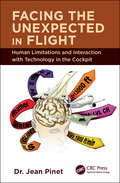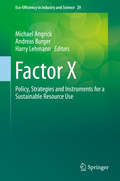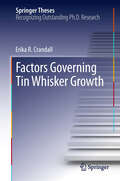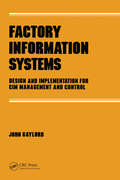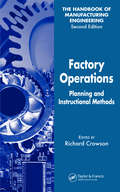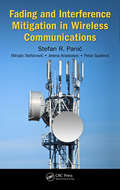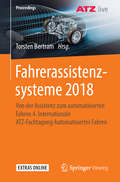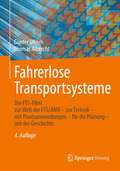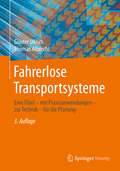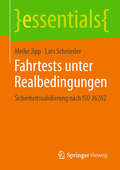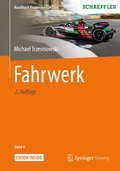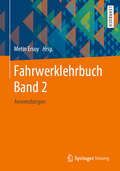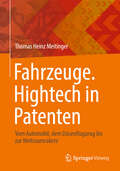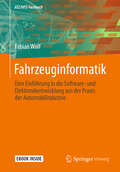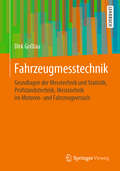- Table View
- List View
Facing the Unexpected in Flight: Human Limitations and Interaction with Technology in the Cockpit
by Jean PinetAirline pilots often have to face sudden, unexpected situations that can become potentially dangerous. They are trained to deal with these situations, but sometimes the lack of time before the situation deteriorates and the associated stress can compromise their basic cognitive sequence and lead to a serious incident or even an accident. This book
Factor X
by Harry Lehmann Andreas Burger Michael AngrickFactor X: Re-source--Designing the Recycling Society explores the role of recycling in efforts to achieve the sustainable world envisioned in the Federal Environment Ministry's Resource Efficiency Programme, known as ProgRess. The chapters build a roadmap to a Recycling Society in which the decoupling of resource consumption and economic growth is accomplished.
Factories of the Future: Technological Advancements in the Manufacturing Industry
by Harleen Kaur Chandan Deep SinghFACTORIES OF THE FUTURE The book provides insight into various technologies adopted and to be adopted in the future by industries and measures the impact of these technologies on manufacturing performance and their sustainability. Businesses and manufacturers face a slew of demands beyond the usual issues of staying agile and surviving in a competitive landscape within a rapidly changing world. Factories of the Future deftly takes the reader through the continuous technology changes and looks ten years down the road at what manufacturing will mostly look like. The book is divided into two parts: Emerging technologies and advancements in existing technologies. Emerging technologies consist of Industry 4.0 and 5.0 themes, machine learning, intelligent machining, advanced maintenance, reliability, and green manufacturing. The advances of existing technologies consist of digital manufacturing, artificial intelligence in machine learning, Internet of Things, product life cycle, and the impact of factories on the future of manufacturing performance of the manufacturing industries. Readers will find in this illuminating book: A comprehensive discussion of almost all emerging technologies, including “green” manufacturing; An overview of the social, economic, and technical aspects of these technologies; An explanation of these technological advancements on manufacturing performance, through case studies and other analytical tools.
Factors Affecting the Removal of Ammonia from Air on Carbonaceous Materials
by Camille PetitAir pollution related to the release of industrial toxic gases, represents one of the main concerns of our modern world owing to its detrimental effect on the environment. To tackle this growing issue, efficient ways to reduce/control the release of pollutants are required. Adsorption of gases on porous materials appears as a potential solution. However, the physisorption of small molecules of gases such as ammonia is limited at ambient conditions. For their removal, adsorbents providing strong adsorption forces must be used/developed. In this study, new carbon-based materials are prepared and tested for ammonia adsorption at ambient conditions. Characterization of the adsorbents' texture and surface chemistry is performed before and after exposure to ammonia to identify the features responsible for high adsorption capacity and for controlling the mechanisms of retention. The characterization techniques include: nitrogen adsorption, thermal analysis, potentiometric titration, FT-IR spectroscopy, X-ray diffraction, Energy Dispersive X-ray spectroscopy, X-ray photoelectron spectroscopy and Electron Microscopy. The results obtained indicate that ammonia removal is governed by the adsorbent's surface chemistry. On the contrary, porosity (and thus physisorption) plays a secondary role in this process, unless strong dispersive forces are provided by the adsorbent. The surface chemistry features responsible for the enhanced ammonia adsorption include the presence of oxygen-(carboxyl, hydroxyl, epoxy) and sulfur- (sulfonic) containing groups. Metallic species improve the breakthrough capacity as well as they lead to the formation of Lewis acid-base interactions, hydrogen-bonding or complexation. In addition to the latter three mechanisms, ammonia is retained on the adsorbent surface via Brønsted acid-base interactions or via specific reactions with the adsorbent's functionalities leading to the incorporation of ammonia into the adsorbent's matrix. Another mechanism involves dissolution of ammonia in water when moisture is present in the system. Even though this process increases the breakthrough capacity of a material, it provides rather weak retention forces since ammonia dissolved in water is easily desorbed from the adsorbent's surface.
Factors Governing Tin Whisker Growth
by Erika R CrandallTin (Sn) whiskers are electrically conductive, single crystal eruptions that grow from Sn film surfaces. Their high aspect ratio presents reliability problems for the electronics industry due to bridging and metal arcing, leading to malfunctions and catastrophic failures in many electronic systems (including satellite and defense sectors). Due to legislation in the EU, Japan, and the U.S., mandating a gradual shift from lead (Pb)-based to lead-free solders and board finishes, there has been a reemergence of Sn whiskers. Continuing reports of Sn whisker induced failures coupled with the lack of an industry-accepted understanding of whisker growth and/or test methods to identify whisker prone products has made pure/high Sn substitutes a risky proposition in high reliability systems. This thesis is designed to clarify and control the fundamental mechanisms that govern whisker formation. The research focuses on reproducible "laboratory" created whiskers under a variety of rigorously controlled environmental factors such as film thickness, film stress, substrate material, gas environment, and humidity exposure, which are known to play a significant role in whisker production. The ultimate question of how to impede and/or prevent whisker growth is also addressed and shows that whisker prevention is possible via hard metal capping films, which are impenetrable by whiskers.
Factory Information Systems: Design and Implementation for Cim Management and Control (Manufacturing Engineering And Materials Processing Ser. #23)
by John GaylordThis book tells how to develop a successful factory information system to manage and control computer integrated manufacturing (CIM)operations. It is directed and dedicated to those people who are involved in the preservation and enhancement of historical manufacturing strength.
Factory Operations: Planning and Instructional Methods (Handbook of Manufacturing Engineering, Second Edition)
by Richard CrowsonVolume two of the second edition of the comprehensive Handbook of Manufacturing Engineering illuminates the role of the manufacturing engineer as the key component of factory operation. The focus is on the planning and instruction duties that are critical to successful operations management, which fall upon the manufacturing engineer who may be unf
Facts of Matter and Light: Ten Physics Experiments that Shaped Our Understanding of Nature
by Christian Maes. The main aim of this book is to shine a spotlight on key experiments and their crucial importance for advancing our understanding of physics. Physics is an empirical science, and experiments have always been a driving force in the development of our understanding of nature. Facts matter. In that sense, the book attempts to be complementary to the many popularizations of theoretical physics, and to counterbalance the frequent emphasis there on more speculative ideas.Experimental physics is also an essential pillar in physics teaching, as well as helping broader audiences to better understand important concepts, particularly in challenging fields such as relativity or quantum physics, where our common sense intuition often fails.Readers are taken on an historical journey, starting with “Free Fall” and culminating in “Spooky Action at a Distance”. En route they will encounter many important branches of physics, whose main ideas and theoretical description will be given a more empirical meaning. At the end, the reader is invited to reflect on what could be exciting and important directions for fundamental physics. All readers with an undergraduate degree in physical sciences or engineering will enjoy and learn much from this stimulating and original text.
Fading and Interference Mitigation in Wireless Communications
by Stefan Panic Mihajlo Stefanovic Jelena Anastasov Petar SpalevicFading and Interference Mitigation in Wireless Communications will help readers stay up to date with recent developments in the performance analysis of space diversity reception over fading channels in the presence of cochannel interference. It presents a unified method for computing the performance of digital communication systems characterized by a variety of modulation and detection types and channel models. The book includes coverage of multichannel reception in various fading environments, influence of cochannel interference, and macrodiversity reception when channels are simultaneously affected by various types of fading and shadowing.
Fading and Shadowing in Wireless Systems
by P. Mohana ShankarThe study of signal transmission and deterioration in signal characteristics as the signal propagates through wireless channels is of great significance. The book presents a comprehensive view of channel degradation arising from fading and shadowing. Various statistical models including simple, hybrid, compound, complex and cascaded ones are presented with detailed derivations along with measures to quantify the deterioration such as the amount of fading, error rates and outage probabilities. The models range from the Rayleigh and Rician through Suzuki, generalized K, cascaded and alpha-mu and similar ones. This is followed by the analysis of mitigation of fading and shadowing through diversity (simple, hybrid, micro- and macro- level) and combining algorithms. The density and distribution functions, error rates and outages are derived and results analyzed to quantify the improvements. The effects of co-channel interference before and after the implementation of diversity are also analyzed. To facilitate easy understanding of the models and analysis, the background information in terms of probability and random variables is presented with relevant derivations of densities of linear and nonlinear transformation of random variables, the sums, products, ratios as well as order statistics of random variables of all types. The book also provides material on digital modems of interest in wireless systems. Thus, the book with 1100+ equations and 350+ Matlab generated figures and tables is an ideal source for students, educators, researchers and professionals in wireless communications allowing access to information currently unavailable.
Fading and Shadowing in Wireless Systems
by P. Mohana ShankarThe study of signal transmission and deterioration in signal characteristics as the signal propagates through wireless channels is of great significance. The book presents a comprehensive view of channel degradation arising from fading and shadowing. Various statistical models including simple, hybrid, compound, complex and cascaded ones are presented with detailed derivations along with measures to quantify the deterioration such as the amount of fading, error rates and outage probabilities. The models range from the Rayleigh and Rician through Suzuki, generalized K, cascaded and alpha-mu and similar ones. This is followed by the analysis of mitigation of fading and shadowing through diversity (simple, hybrid, micro- and macro- level) and combining algorithms. The density and distribution functions, error rates and outages are derived and results analyzed to quantify the improvements. The effects of co-channel interference before and after the implementation of diversity are also analyzed. To facilitate easy understanding of the models and analysis, the background information in terms of probability and random variables is presented with relevant derivations of densities of linear and nonlinear transformation of random variables, the sums, products, ratios as well as order statistics of random variables of all types. The book also provides material on digital modems of interest in wireless systems. Thus, the book with 1100+ equations and 350+ Matlab generated figures and tables is an ideal source for students, educators, researchers and professionals in wireless communications allowing access to information currently unavailable.
Fahrdynamik der Schienenfahrzeuge: Grundlagen der Leistungsauslegung sowie der Energiebedarfs- und Fahrzeitberechnung
by Martin KacheDas Buch stellt anschaulich und aktuell fahrdynamische Zusammenhänge dar. Es beschreibt deren Bewegungsverhalten in Längsrichtung und den damit verbundenen Leistungs-, Energie- und Zeitbedarf. Fahrdynamische Fragestellungen sind eng mit der Auslegung von Antriebs- und Bremsanlagen von Fahrzeugen sowie der Formgebung der Fahrzeuge und Fragen der Aerodynamik verbunden. Das Buch liefert Kenntnisse über fahrdynamische Grundlagen und hilft dabei, sich in dem komplexen Gebiet der Fahrdynamik des Schienenverkehrs zurecht zu finden. Anhand zahlreicher Verständnisfragen und Rechenaufgaben am Ende eines jeden Kapitels kann das erlernte Wissen vertieft werden.Zusatzmaterialien mit Hintergrundwissen und fahrdynamischen Daten sowie Lösungen zu den Rechenaufgaben sind auf der Verlagshomepage über einen Link beim jeweiligen Kapitel abrufbar.
Fahrerassistenzsysteme 2018: Von der Assistenz zum automatisierten Fahren 4. Internationale ATZ-Fachtagung Automatisiertes Fahren (Proceedings)
by Torsten BertramDer Tagungsband zur ATZlive-Veranstaltung "Fahrerassistenzsysteme 2018" thematisiert in Vorträgen u.a. welche fahrfremden Tätigkeiten der Fahrer im automatisierten Modus wie ausüben darf und wie sich die SAE-Level 3 und 4 voneinander abgrenzen lassen. Weitere Aspekte sind der Fahrer (Mensch) in der Interaktion mit dem Fahrzeug (Maschine) sowie die damit verbundenen Interdependenzen.Die Tagung ist eine unverzichtbare Plattform für den Wissens- und Gedankenaustausch von Forschern und Entwicklern aller Unternehmen und Institutionen, um wichtige Impulse für ihre tägliche Arbeit zu erhalten.
Fahrerlose Transportsysteme: Die FTS-Fibel - zur Welt der FTS/AMR - zur Technik - mit Praxisanwendungen - für die Planung - mit der Geschichte
by Günter Ullrich Thomas AlbrechtDieses Fachbuch gibt einen umfassenden Überblick über die moderne Intralogistik mit Fahrerlosen Transportsystemen (FTS). Diese flurgebundenen Systeme werden seit über 60 Jahren innerbetrieblich in fast allen Branchen der Industrie sowie in vielen öffentlichen Bereichen, wie z. B. Krankenhäusern, eingesetzt. Das Buch zeigt, wie vielfältig die Anwendungen sind und welche technologischen Standards zur Verfügung stehen. Dabei werden zahlreiche Umsetzungen aus den unterschiedlichsten Branchen, wie beispielsweise Automobil-, Elektro-, Pharma und Lebensmittelindustrie vorgestellt. Ein weiterer Schwerpunkt ist die ganzheitliche Planung solcher Systeme, die ausführlich mit allen Planungsschritten beschrieben wird, angereichert durch zahlreiche wertvolle Hinweise. Die vierte Auflage wurde vollständig überarbeitet und geht auf aktuelle Entwicklungen ein, wie standardisierte Datenschnittstellen, autonome Funktionen zur Flexibilisierung oder neue Anwendungen in öffentlich zugänglichen Bereichen. In diesem Zuge werden Sinnhaftigkeit und Wirtschaftlichkeit der neuen Entwicklungen ebenfalls beleuchtet.
Fahrerlose Transportsysteme: Eine Fibel - mit Praxisanwendungen - zur Technik - für die Planung
by Günter Ullrich Thomas AlbrechtDieses Fachbuch gibt einen umfassenden Überblick über das moderne Organisationsmittel der Intralogistik. Fahrerlose Transportsysteme (FTS) sind flurgebundene Systeme, die innerbetrieblich innerhalb und/oder außerhalb von Gebäuden eingesetzt werden. Seit Mitte der 1990er Jahre drängt das FTS erfolgreich in fast alle Branchen der Industrie und in viele öffentliche Bereiche, wie z. B. Krankenhäuser. Es werden die technologischen Standards von allen FTS-relevanten Komponenten und Funktionen erläutert sowie zahlreiche Praxisbeispiele z. B. aus der Automobilindustrie, Elektro- und Lebensmittelindustrie vorgestellt. Ein weiterer Schwerpunkt ist die an den VDI-Richtlinien angelehnte praxisnahe Planung solcher Intralogistik-Systeme einschließlich Hinweisen und Tipps für ein erfolgreiches Projektmanagement bei der Einführung eines FTS. Die vorliegende Auflage wurde komplett überarbeitet, neu strukturiert und spiegelt die rasanten Entwicklungen in der Technik und den Märkten wider.
Fahrradpiktogramme auf der Fahrbahn: Ein Beitrag zu Flächengerechtigkeit und Verkehrssicherheit in beengten Verhältnissen (Verkehrspsychologie)
by Stefanie RufFahrradpiktogramme auf der Fahrbahn können genutzt werden, um Radfahrende in beengten Verhältnissen auf ihr Recht, auf der Fahrbahn zu fahren, aufmerksam zu machen. Gleichzeitig dienen sie als Hinweis für Kfz-Fahrende, auf Radfahrende auf der Fahrbahn vorbereitet zu sein und diesen rücksichtsvoll zu begegnen. International sind sicherheitsförderliche Effekte der Maßnahmen gut belegt, eine Untersuchung im deutschen Verkehrskontext stand bisher jedoch noch aus. Stefanie Ruf begleitet die Umsetzung von Piktogrammen in verschiedenen deutschen Kommunen mit Vorher-Nachher-Befragungen im Feld sowie mit einer ergänzenden kontrollierten Online-Befragung. Ihre Erkenntnisse zeigen, dass Fahrradpiktogramme auf der Fahrbahn auch in Deutschland einen Beitrag zu Flächengerechtigkeit und Verkehrssicherheit leisten können, gleichzeitig werden auch wichtige Einschränkungen diskutiert.
Fahrtests unter Realbedingungen: Sicherheitsvalidierung nach ISO 26262 (essentials)
by Lars Schnieder Meike JippFahrerassistenz, Fahrzeugautomation und vernetzte Systeme beschreiben die Zukunft der Automobilität und schüren die Erwartung essentiell verbesserter Verkehrssicherheit. Meike Jipp und Lars Schnieder verknüpfen eine ingenieurmäßige Sichtweise, die durch funktionale Sicherheit (ISO 26262:2018) und sichere Sollfunktion (ISO/PAS 21448:2019) geprägt ist, mit der Perspektive der Ingenieurpsychologie, die mithilfe sozialwissenschaftlicher Methoden menschzentrierte Automobilität sicher zu gestalten versucht. Der Mensch wird je nach Automationsgrad als Rückfallebene mit im Gesamtsystem berücksichtigt und auch zukünftig bei der Gestaltung vernetzter Systeme, die ihr Verhalten aufeinander abstimmen, eine zentrale Rolle spielen.Die Autoren: Prof. Dr. Meike Jipp forscht am Deutschen Zentrum für Luft- und Raumfahrt (DLR) e.V. im Institut für Verkehrssystemtechnik. Dr.-Ing. Lars Schnieder ist als Geschäftsführer einer Software-Entwicklungsfirma für das Geschäftsfeld Sicherheitsbegutachtung verantwortlich.
Fahrwerk (Handbuch Rennwagentechnik #4)
by Michael TrzesniowskiIn diesem Buch lernt der Leser die wesentlichen Unterschiede zum Pkw durch die nach Baugruppen aufgeteilte Analyse kennen. So erhält er das Rüstzeug, die erworbenen detaillierten Kenntnisse in die Konstruktion und Entwicklung von Wettbewerbsfahrzeugen einzubringen. Das Fahrwerk bestimmt wohl wie keine andere Baugruppe das Fahrverhalten und damit die „DNA“ eines Rennfahrzeugs. Beginnend beim Reifen – dem entscheidenden mechanischen Bauteil – werden alle Bauelemente der Radaufhängung inklusive Lenkung sowie Bremsanlage vorgestellt und besprochen. Der Schwerpunkt liegt auf den Doppelquerlenker- und Federbeinachsen. Die Konstruktion von Radaufhängungen beginnt mit kinematischen Betrachtungen, führt über Bauteilauslegung zu fahrdynamischen Betrachtungen des Gesamtfahrzeugs. Letztendlich sollen die Maximalkräfte der Reifen in Quer- und Umfangsrichtung ausgeschöpft werden und das Fahrzeug dabei beherrschbar bleiben. Durch die detaillierte, in die Tiefe gehende Darstellung ist das Werk für den interessierten Motorsport-Enthusiasten ebenso geeignet wie für den in der Praxis stehenden Ingenieur, der sich den Fragen rund um Rennfahrwerke zuwendet. Das Formelmaterial ist so aufbereitet, dass das Buch auch als Nachschlagwerk eingesetzt werden kann.
Fahrwerklehrbuch Band 2: Anwendungen
by Metin ErsoyFahrwerke moderner Pkw stellen eine Kombination mechanischer, elektrischer, elektronischer und zum kleinen Teil hydraulischer/pneumatischer Komponenten dar, wobei sich mit jeder Neuentwicklung der Anteil elektronischer Steuerungs- sowie Regelsysteme erweitert und der Funktionsumfang der fahrdynamisch beeinflussten Eigenschaften zunimmt. Mit Blick auf das Fahrwerk sind in diesen zwei Bänden alle konventionellen Elemente und deren Zusammenwirken mit elektronischen Systemen dargestellt. Dabei werden zunächst Grundlagen und Auslegung, danach in besonders praxisnaher Darstellung die Fahrdynamik, Fahrkomfort, Fahrverhalten dargelegt. Es folgen ausführliche Beschreibungen und Erläuterungen der modernen Fahrwerk-Komponenten. Eigene Kapitel widmen sich den Achsen, Radaufhängungen und Prozessen für die Fahrwerkentwicklung. Die Bände enthalten außerdem die aktuellen Themen wie autonomes Fahren, Elektrifizierung, Fahrerassistenzsysteme sowie die Zukunftstendenzen im Fahrwerk.
Fahrzeugaerodynamik: Basiswissen für das Studium (ATZ/MTZ-Fachbuch)
by Thomas SchützFahrleistung und Verbrauch, Fahrverhalten und Komfort eines Automobils werden nachhaltig von seinen aerodynamischen Eigenschaften bestimmt. Ein niedriger Luftwiderstand ist beispielsweise die Voraussetzung dafür, dass die hochgesteckten Verbrauchsziele erreicht werden. Das vorliegende Buch wendet sich an Studenten des Maschinenbaus, Fahrzeugtechnik, der Physik und anderer verwandter Studienschwerpunkte, an Automobilingenieure in der Industrie, in Forschung und Lehre, in den Technischen Überwachungsvereinen und Behörden. Fahrzeugtechniker, Konstrukteure, Versuchs- und Berechnungsingenieure sollen ebenso angesprochen werden wie Aerodynamiker, die aus anderen Branchen kommen. Es richtet sich aber auch an Designer und an Fachjournalisten sowie an von der Technik begeisterte Automobilisten.
Fahrzeugdynamik: Theorie und Anwendung
by Reza N. JazarDieses Lehrbuch für Fortgeschrittene eignet sich für Studenten in Kursen zur Fahrzeugdynamik, die sich im letzten Jahr ihres Grundstudiums oder im ersten Jahr ihres Graduiertenstudiums befinden. Es ist auch für Maschinenbauingenieure, Automobilingenieure und Forscher auf dem Gebiet der Fahrzeugdynamik zur Weiterbildung oder als Nachschlagewerk geeignet. Es behandelt grundlegende und fortgeschrittene Themen, wobei Grundkenntnisse in Kinematik und Dynamik sowie in numerischen Methoden vorausgesetzt werden.Der Inhalt ist auf einem theoretisch-praktischen Niveau gehalten, wobei ein starker Schwerpunkt auf der Anwendung liegt. Diese dritte Auflage wurde um 25 % gekürzt, so dass der Stoff in einem Semester abgedeckt werden kann, im Gegensatz zur vorherigen Auflage, die zwei Semester für die Abdeckung benötigte. Das Lehrbuch ist in vier Teile gegliedert:Fahrzeugbewegung: behandelt die Reifendynamik, die Vorwärtsdynamik des Fahrzeugs und die Dynamik desAntriebsstrangsFahrzeugkinematik: behandelt angewandte Kinematik, angewandte Mechanismen, Lenkungsdynamik und AufhängungsmechanismenFahrzeugdynamik: umfasst angewandte Dynamik, Fahrzeugdynamik in der Ebene und FahrzeugrolldynamikFahrzeugschwingungen: behandelt angewandte Schwingungen, Fahrzeugschwingungen und AufhängungsoptimierungDie Konzepte der Fahrzeugdynamik werden detailliert behandelt, wobei der Schwerpunkt auf ihren praktischen Einsatz gelegt wird. Außerdem werden verwandte Theoreme und formale Beweise zusammen mit Fallbeispielen bereitgestellt. Die Leser schätzen die benutzerfreundliche Darstellung der wissenschaftlichen und technischen Aspekte der Fahrzeugmechanik und lernen, wie sie das Fahrverhalten von Fahrzeugen analysieren und optimieren können.
Fahrzeuge. Hightech in Patenten: Vom Automobil, dem Düsenflugzeug bis zur Weltraumrakete
by Thomas Heinz MeitingerDie Entwicklung der Menschheit geht einher mit der Entwicklung von Fortbewegungsmitteln. Den Anfang machte die Fortbewegung mit reiner Muskelkraft, dann folgten Automobile, Schiffe und Schienenfahrzeuge. Mit Flugzeugen wurden die Lüfte erobert und mit Weltraumraketen beginnen die Menschen ihren Planeten zu verlassen und das Weltall zu erkunden. Die zunehmenden Möglichkeiten der Fortbewegung führten zu immer neuen Erkenntnissen und erweiterten das Weltbild der Menschheit. Dieses Fachbuch lässt diese Entwicklung anhand von Patentschriften Revue passieren. Hierdurch wird verständlich, wie sich eine technische Entwicklung ergibt und in welcher Weise die zivilisatorische und gesellschaftliche Entwicklung der Menschheit mit der Fortentwicklung der Technologie zusammenhängt. Nicht zuletzt soll dem geneigten Leser die Möglichkeit geboten werden, ein Interesse und ein Verständnis für Technik zu erwerben.
Fahrzeuggetriebe: Grundlagen, Auswahl, Auslegung und Konstruktion (Vdi-buch Ser.)
by Harald Naunheimer Bernd Bertsche Joachim Ryborz Wolfgang Novak Peter FietkauFür Konstrukteure werden alle Kenntnisse der modernen Getriebetechnik vollständig, praxisgerecht und fundiert bereitgestellt: Grundlagen, Entwicklungsabläufen, Anforderungen. Die komplette Systematik: Aufbau, Triebstrangkonzepte, Auslegung und Gestaltung wichtiger Bauteile. Beispiele ausgeführter Konstruktionen, Zuverlässigkeit, Lebensdauer, notwendige Elektronik und Informationsvernetzung.
Fahrzeuginformatik: Eine Einführung in die Software- und Elektronikentwicklung aus der Praxis der Automobilindustrie (ATZ/MTZ-Fachbuch)
by Fabian WolfDieses Fach- und Lehrbuch enthält die heutigen Grundlagen und Sicht der Praxis zu Elektronik und Software im Fahrzeug. Es dient damit als Basis für die Umsetzung neuer Trends, wissenschaftliche Arbeiten und ökonomische Entscheidungen. Elektronikarchitektur, Softwareentwicklung und Test sowie die zugehörigen Prozesse für zulassungsrelevante Systeme werden vorgestellt. Die „Fahrzeuginformatik“ spielt als Schnittstelle zwischen Produktvision und deren konkreter Umsetzung eine Schlüsselrolle in der Elektromobilität. Damit ist dieser Begriff rein sprachlich das deutsche Pendant zum „Automotive Software Engineering“ und definiert darüber hinaus ganzheitlich eine neue Disziplin in der Entwicklung der Fahrzeuggenerationen von morgen.Die Zielgruppen sind in erster Linie angehende Fachkräfte der Mechatronik, Studierende und Berufseinsteiger im Bereich der Fahrzeugelektronik und Fahrzeuginformatik sowie sämtliche Mitarbeiter der Automobilindustrie, die sich auf den anstehenden Wandel nachhaltig vorbereiten wollen, um Entscheidungen auf der Basis von Fakten zu treffen. Damit empfiehlt sich dieses Werk auch als fachliche Basis für Entscheider außerhalb der Automobilindustrie, die den digitalen Wandel nachhaltig und fundiert vorantreiben oder diskutieren wollen.
Fahrzeugmesstechnik: Grundlagen der Messtechnik und Statistik, Prüfstandstechnik, Messtechnik im Motoren- und Fahrzeugversuch
by Dirk GoßlauDem Fahrzeugtechniker wird ein Übersichts- und Nachschlagewerk zu den angegebenen Messtechniken an die Hand gegeben. Dabei wird neben den physikalischen Aspekten auf die praxisrelevanten Eigenschaften und Besonderheiten eingegangen. Größen- und Rechenbeispiele veranschaulichen das Thema. Ergänzend werden grundlegende statistische Methoden zur Fehlerbetrachtung und Bewertung von Messergebnissen dargestellt.
